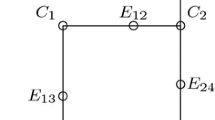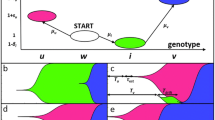Abstract
We investigate the effect of deleterious mutations on the process of fixation of new advantageous mutants in an asexual population. In particular we wish to study the dependence of the process on the strength of the deleterious mutations. We suppose the existence of epistatic interaction between the genes. We study the model by means of branching process theory and also by numerical simulations. Our results show the occurrence of two distinct regimes of behavior for the probability of fixation of these variants. The occurrence of either regime depends on the ratio between the selective advantage of the beneficial mutation s b and on the selective parameter for deleterious mutations s b . In the former, which takes place for s b /s d ≲ 1, the probability of fixation increases with the epistasis parameter α, whereas for s b /s d ≫ 1 the probability of fixation is a complex function of α and the mutation rate U. Surprisingly, we find that for the multiplicative landscape (α = 1) the probability of fixation P fix is given by \(P_{fix} = \pi (s_b )e^{{U \mathord{\left/ {\vphantom {U {s_d }}} \right. \kern-\nulldelimiterspace} {s_d }}} \) where π (s b ) is the probability of fixation for the two-allele model in the absence of mutations as calculated by Haldane (1927, Proc. Camb. Phil. Soc., 26, 220–230) and Kimura (1962, Genetics, 47, 713–719).
Similar content being viewed by others
References
Barton, N. H. (1995). Linkage and the limits to natural selection. Genetics 140, 821–841.
Campos, P. R. A., C. Adami and C. O. Wilke (2003). Modelling stochastic clonal interference. Modeling in Molecular Biology (Springer Series in Natural Computing) (to appear).
Campos, P. R. A. and J. F. Fontanari (2000). Finite-size scaling of the error threshold transition in finite populations. J. Phys. A: Math. Gen. 32, L1–L7.
Colato, A. and J. F. Fontanari (2001). Soluble model for the accumulation of mutations in asexual populations. Phys. Rev. Lett. 87, art. no. 238102.
Felsenstein, J. (1974). The evolutionary advantage of recombination. Genetics 78, 737–756.
Fisher, R. A. (1922). On the dominance ratio. Proc. R. Soc. Edinb. Sect. B Biol. Sci. 42, 321–341.
Fisher, R. A. (1930). The Genetical Theory of Natural Selection, Clarendon Press.
Gerrish, P. (2001). The rythm of microbial adaptation. Nature 413, 299–302.
Gerrish, P. J. and R. E. Lenski (1998). The fate of competing beneficial mutations in an asexual population. Genetica 102.
Gordo, I. and B. Charlesworth (2000). The degeneration of asexual haploid populations and the speed of Muller’s ratchet. Genetics 154, 1379–1387.
Haigh, J. (1978). The accumulation of deleterious genes in a population—Muller’s ratchet. Theor. Popul. Biol. 14, 251–267.
Haldane, J. B. S. (1927). A mathematical theory of natural and artificial selection. Part v: selection and mutation. Proc. Camb. Phil. Soc. 26, 220–230.
Harris, T. E. (1963). The Theory of Branching Processes, Springer.
Higgs, P. G. and G. Woodcock (1995). The accumulation of mutations in asexual populations and the structure of genealogical trees in the presence of selection. J. Math. Biol. 33, 677–702.
Hill, W. G. and A. Robertson (1966). The effect of linkage on the limits to artificial selection. Genet. Res. 8, 269–294.
Johnson, T. and N. H. Barton (2002). The effect of deleterious alleles on adaptation in asexual organisms. Genetics 162, 395–411.
Kimura, M. (1962). On the probability of fixation of mutant genes in a population. Genetics 47, 713–719.
Kimura, M. and J. F. Crow (1964). The number of alleles that can be maintained in a finite populations. Genetics 49, 725–738.
Kimura, M. and T. Maruyama (1966). The mutational load with epistatic gene interactions in fitness. Genetics 54, 1337–1351.
Muller, H. J. (1964). The relation of recombination to mutational advance. Mutat. Res. 1, 2–9.
Orr, H. A. (2000). The rate of adaptation in asexuals. Genetics 155, 961–968.
Peck, J. R. (1994). A ruby in the rubbish: beneficial mutations, deleterious mutations and the evolution of sex. Genetics 137, 597–606.
Watterson, G. A. (1975). Number of segregating sites in genetic models without recombination. Theor. Popul. Biol. 10, 256–276.
Wilke, C. O. (2003). Probability of fixation of an advantageous mutant in a viral quasispecies. Genetics 162, 467–474.
Author information
Authors and Affiliations
Corresponding author
Rights and permissions
About this article
Cite this article
Campos, P.R.A. Fixation of beneficial mutations in the presence of epistatic interactions. Bull. Math. Biol. 66, 473–486 (2004). https://doi.org/10.1016/j.bulm.2003.08.012
Received:
Accepted:
Issue Date:
DOI: https://doi.org/10.1016/j.bulm.2003.08.012




